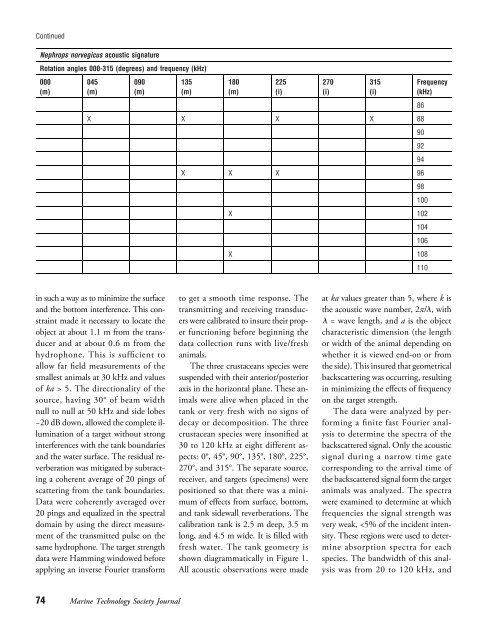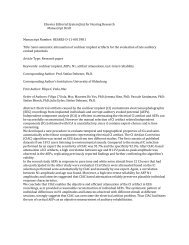Acoustic Signatures of Three Marine Arthropods, Squilla mantis ...
Acoustic Signatures of Three Marine Arthropods, Squilla mantis ...
Acoustic Signatures of Three Marine Arthropods, Squilla mantis ...
You also want an ePaper? Increase the reach of your titles
YUMPU automatically turns print PDFs into web optimized ePapers that Google loves.
Continued<br />
Nephrops norvegicus acoustic signature<br />
Rotation angles 000-315 (degrees) and frequency (kHz)<br />
000<br />
(m)<br />
045<br />
(m)<br />
090<br />
(m)<br />
in such a way as to minimize the surface<br />
and the bottom interference. This constraint<br />
made it necessary to locate the<br />
object at about 1.1 m from the transducer<br />
and at about 0.6 m from the<br />
hydrophone. This is sufficient to<br />
allow far field measurements <strong>of</strong> the<br />
smallest animals at 30 kHz and values<br />
<strong>of</strong> ka > 5. The directionality <strong>of</strong> the<br />
source, having 30° <strong>of</strong> beam width<br />
null to null at 50 kHz and side lobes<br />
−20 dB down, allowed the complete illumination<br />
<strong>of</strong> a target without strong<br />
interferences with the tank boundaries<br />
and the water surface. The residual reverberation<br />
was mitigated by subtracting<br />
a coherent average <strong>of</strong> 20 pings <strong>of</strong><br />
scattering from the tank boundaries.<br />
Data were coherently averaged over<br />
20 pings and equalized in the spectral<br />
domain by using the direct measurement<br />
<strong>of</strong> the transmitted pulse on the<br />
same hydrophone. The target strength<br />
data were Hamming windowed before<br />
applying an inverse Fourier transform<br />
135<br />
(m)<br />
180<br />
(m)<br />
X X X X 88<br />
90<br />
92<br />
94<br />
X X X 96<br />
98<br />
100<br />
X 102<br />
104<br />
106<br />
X 108<br />
110<br />
74 <strong>Marine</strong> Technology Society Journal<br />
225<br />
(i)<br />
to get a smooth time response. The<br />
transmitting and receiving transducers<br />
were calibrated to insure their proper<br />
functioning before beginning the<br />
data collection runs with live/fresh<br />
animals.<br />
The three crustaceans species were<br />
suspended with their anterior/posterior<br />
axis in the horizontal plane. These animals<br />
were alive when placed in the<br />
tank or very fresh with no signs <strong>of</strong><br />
decay or decomposition. The three<br />
crustacean species were insonified at<br />
30 to 120 kHz at eight different aspects:<br />
0°, 45°, 90°, 135°, 180°, 225°,<br />
270°, and 315°. The separate source,<br />
receiver, and targets (specimens) were<br />
positioned so that there was a minimum<br />
<strong>of</strong> effects from surface, bottom,<br />
and tank sidewall reverberations. The<br />
calibration tank is 2.5 m deep, 3.5 m<br />
long, and 4.5 m wide. It is filled with<br />
fresh water. The tank geometry is<br />
shown diagrammatically in Figure 1.<br />
All acoustic observations were made<br />
270<br />
(i)<br />
315<br />
(i)<br />
Frequency<br />
(kHz)<br />
86<br />
at ka values greater than 5, where k is<br />
the acoustic wave number, 2π/λ, with<br />
λ = wave length, and a is the object<br />
characteristic dimension (the length<br />
or width <strong>of</strong> the animal depending on<br />
whetheritisviewedend-onorfrom<br />
the side). This insured that geometrical<br />
backscattering was occurring, resulting<br />
in minimizing the effects <strong>of</strong> frequency<br />
on the target strength.<br />
The data were analyzed by performing<br />
a finite fast Fourier analysis<br />
to determine the spectra <strong>of</strong> the<br />
backscattered signal. Only the acoustic<br />
signal during a narrow time gate<br />
corresponding to the arrival time <strong>of</strong><br />
the backscattered signal form the target<br />
animals was analyzed. The spectra<br />
were examined to determine at which<br />
frequencies the signal strength was<br />
very weak,
















